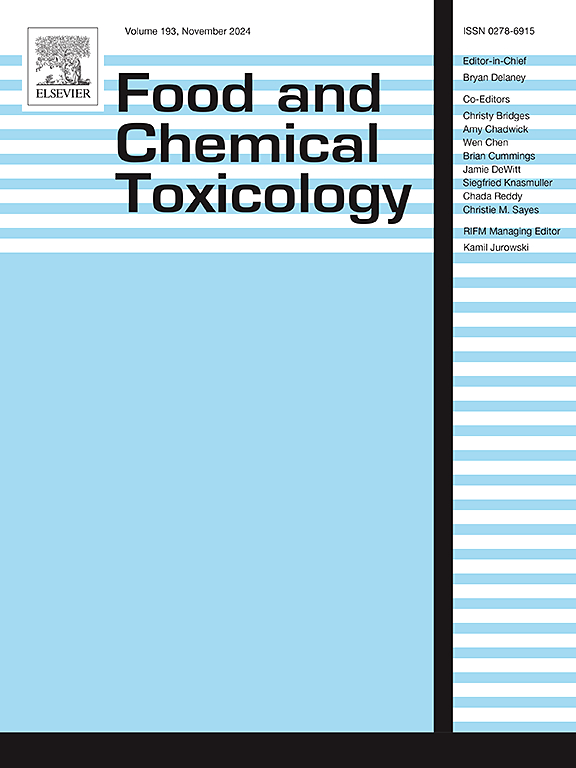Acrylamide exposure in workplace cafeterias: Impact of consumer choices
IF 3.9
3区 医学
Q2 FOOD SCIENCE & TECHNOLOGY
引用次数: 0
Abstract
Eating in workplace cafeterias is a common part of the workday. While nutritional profiles of these menus are often evaluated, exposure to chemical process contaminants like acrylamide receives little attention. This study assessed acrylamide exposure from lunches in two Spanish workplace cafeterias using the duplicate diet method, considering both lower bound (LB) and upper bound (UB) scenarios. Over two weeks, 146 food items were collected from lunch menus, covering combinations of first and second courses, dessert and bread. Potato-based dishes had the highest acrylamide levels (233 μg/kg), followed by stewed lentils (150 μg/kg) and stewed salmon with vegetables (109 μg/kg), while other meals showed lower levels (16–75 μg/kg). Daily acrylamide exposure ranged between 0 and 1.04 μg/kg body weight (bw)/day for women and 0–0.85 μg/kg bw/day for men. Cafeteria-1 offered varied menu combinations, allowing zero acrylamide exposure, while cafeteria-2 had less flexibility. The margin of exposure (MOE) values for neoplastic effects varied from 1221 to 165 (LB) and from 2609 to 163 (UB), suggesting potential health concern. While workplace menus generally comply with nutritional guidelines, consumer choices critically influence acrylamide exposure. Educating consumers on safer food choices and training food handlers to reduce acrylamide in meal preparation are key to mitigating health risks.

在工作场所的自助餐厅用餐是工作日的常见内容。虽然经常对这些菜单的营养成分进行评估,但像丙烯酰胺这样的化学加工污染物却很少受到关注。这项研究采用重复饮食法,同时考虑下限 (LB) 和上限 (UB) 两种情况,评估了两个西班牙工作场所自助餐厅午餐中丙烯酰胺的摄入量。在两周的时间里,从午餐菜单中收集了 146 种食物,包括第一道菜、第二道菜、甜点和面包。马铃薯类菜肴的丙烯酰胺含量最高(每公斤 233 微克),其次是炖扁豆(每公斤 150 微克)和炖三文鱼配蔬菜(每公斤 109 微克),而其他菜肴的丙烯酰胺含量较低(每公斤 16-75 微克)。女性的丙烯酰胺日摄入量为 0-1.04 微克/公斤体重/天,男性为 0-0.85 微克/公斤体重/天。1 号自助餐厅提供多种菜单组合,可实现零丙烯酰胺摄入量,而 2 号自助餐厅的灵活性较低。肿瘤影响的暴露限值(MOE)从 1221 到 165(LB)不等,从 2609 到 163(UB)不等,表明可能存在健康问题。虽然工作场所的菜单一般都符合营养指南,但消费者的选择对丙烯酰胺的摄入量有着至关重要的影响。教育消费者选择更安全的食物,并培训食品处理人员在配餐过程中减少丙烯酰胺的摄入量,是降低健康风险的关键。
本文章由计算机程序翻译,如有差异,请以英文原文为准。
求助全文
约1分钟内获得全文
求助全文
来源期刊

Food and Chemical Toxicology
工程技术-毒理学
CiteScore
10.90
自引率
4.70%
发文量
651
审稿时长
31 days
期刊介绍:
Food and Chemical Toxicology (FCT), an internationally renowned journal, that publishes original research articles and reviews on toxic effects, in animals and humans, of natural or synthetic chemicals occurring in the human environment with particular emphasis on food, drugs, and chemicals, including agricultural and industrial safety, and consumer product safety. Areas such as safety evaluation of novel foods and ingredients, biotechnologically-derived products, and nanomaterials are included in the scope of the journal. FCT also encourages submission of papers on inter-relationships between nutrition and toxicology and on in vitro techniques, particularly those fostering the 3 Rs.
The principal aim of the journal is to publish high impact, scholarly work and to serve as a multidisciplinary forum for research in toxicology. Papers submitted will be judged on the basis of scientific originality and contribution to the field, quality and subject matter. Studies should address at least one of the following:
-Adverse physiological/biochemical, or pathological changes induced by specific defined substances
-New techniques for assessing potential toxicity, including molecular biology
-Mechanisms underlying toxic phenomena
-Toxicological examinations of specific chemicals or consumer products, both those showing adverse effects and those demonstrating safety, that meet current standards of scientific acceptability.
Authors must clearly and briefly identify what novel toxic effect (s) or toxic mechanism (s) of the chemical are being reported and what their significance is in the abstract. Furthermore, sufficient doses should be included in order to provide information on NOAEL/LOAEL values.
 求助内容:
求助内容: 应助结果提醒方式:
应助结果提醒方式:


